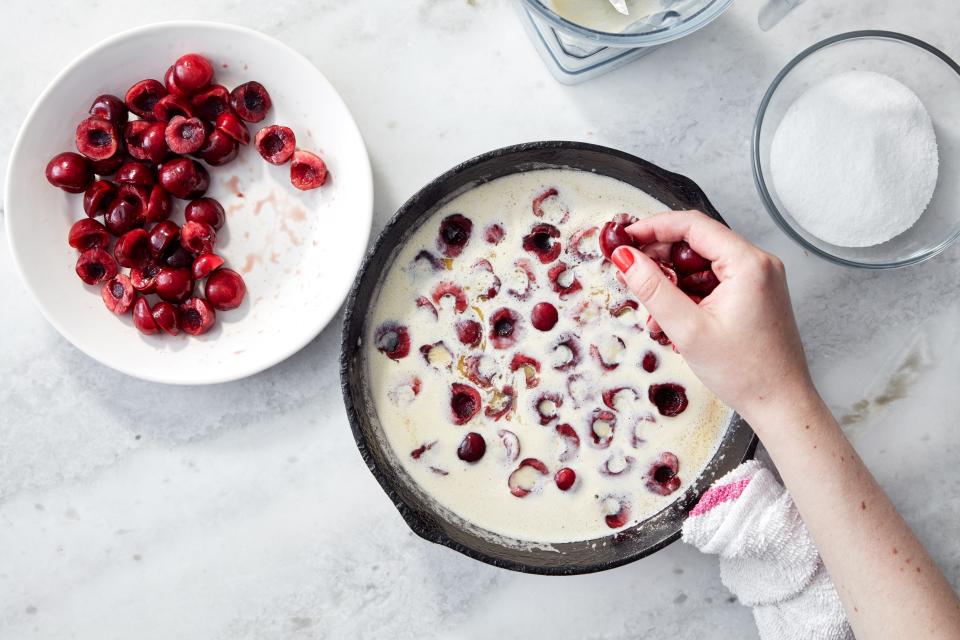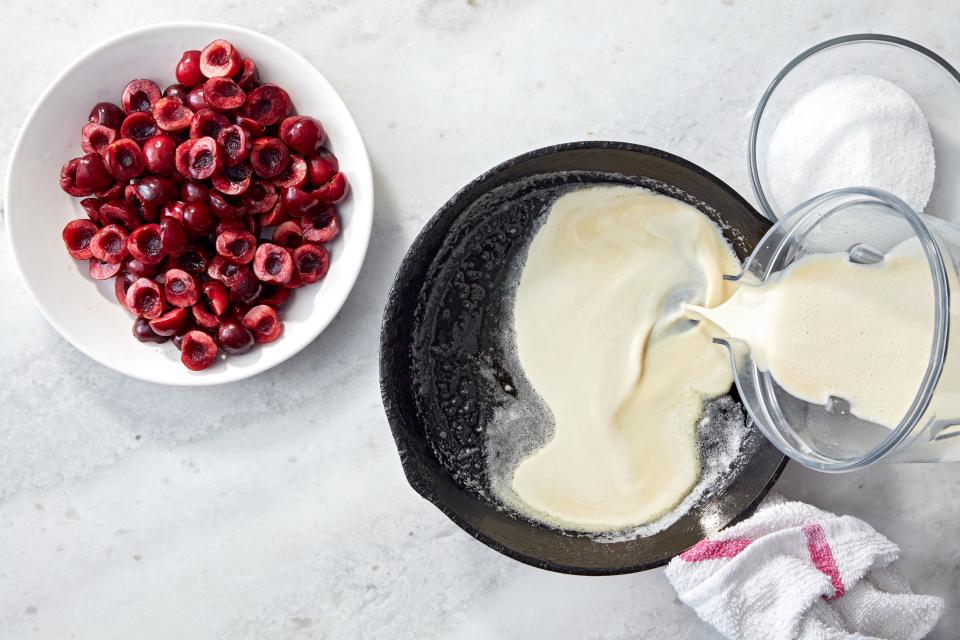How to Make Clafoutis With (Almost) Any Kind of Fruit

Photo by Joseph De Leo, Food styling by Anna Stockwell
Clafoutis might be one of the easiest, most forgiving French desserts. It’s the kind of dish you keep in your back pocket, ready to pull out when you’re at an ill-equipped vacation stay or when friends stop by at the last minute and you suddenly get the urge to whip something up. And because it’s not too sweet, it also makes for a killer low-effort brunch.
What is clafoutis, exactly?
A centuries-old dish from Limousin, France, clafoutis is an eggy, fruit-filled bake that lives somewhere at the intersection of pancake, cobbler, and custard. The word clafoutis is believed to derive from the verb clafir, which means “to fill” in Occitan, a language spoken in parts of France, Catalonia, Italy, and Monaco.
Traditionally made with unpitted sweet cherries, clafoutis recipes are endlessly adaptable. Purists will tell you that using another fruit technically turns this dish into a flognarde, but plenty of classically trained French cooks (including Julia Child and Joël Robuchon) have been known to embrace other kinds of fruit when demonstrating how to make clafoutis. Plus, you can bake it in a pie pan, casserole dish, seasoned cast-iron skillet, or any two- to three-quart heatproof vessel.
How to make clafoutis
Approach clafoutis like a choose-your-own-adventure project: The recipe provides structure, but the twists and changes are all up to you.
Pick your fruit: A fresh cherry clafoutis recipe is a rightful classic, but you can use two cups of pretty much any fruit in our clafoutis recipe (pitted, please; no one wants to crack a tooth on dessert). Peaches, plums, apricots, sweet or sour cherries, or a colorful medley of in-season stone fruits work beautifully. Or try handfuls of juicy summer blueberries, raspberries, blackberries, or currants. Berries will leak their juices into the custard more than stone fruit, but the results will still be delicious. In the fall, use red grapes or sliced apples and pears (you’ll want to sauté those last two in butter before starting the clafoutis, just to soften). Or add a handful of golden raisins, dried cranberries, or halved prunes. And yes, you can use frozen fruit too (don’t thaw it first), so you can make this easy dessert whether it’s cherry season or not.

Clafoutis_CherryDrop_INSET__060619_2036.jpg
Make the batter: The easiest way to simultaneously mix and aerate clafoutis batter is to put everything in a blender and blitz for about two minutes. You might be familiar with this method if you’ve ever made a Dutch baby or Yorkshire pudding—this recipe really isn’t so different. If you don’t have a blender, whisk the mixture in a large bowl until frothy. To take the flavor up a notch, add orange or lemon zest, vanilla or almond extract (or a splash of whiskey, dark rum, or brandy), or spices like ½ tsp. cinnamon, ginger, or cardamom or a ¼ teaspoon nutmeg or allspice. You could also add a sprinkling of nuts, like sliced almonds or chopped pistachios or walnuts (about ½ cup).
To make it gluten-free, swap the all-purpose flour for a gluten-free flour blend that contains xanthan gum (usually denoted as 1:1 or cup-for-cup)—or use almond flour or pecan flour for a nutty twist. For a dairy-free version, substitute almond milk or whichever alt-milk you prefer, and grease the baking dish with coconut oil instead of butter. The only essential ingredient is the eggs, which give clafoutis its custardy flan-like texture.
Choose your baking vessel: Any two- to three-quart baking vessel or 10" ovenproof skillet will work. Choose something sturdy that can go into the oven relatively empty (i.e., no glass). Casually toss a knob of butter into your baking vessel and slide it into the oven while it preheats. As the butter melts, the pan will get hot; when the clafoutis batter meets the hot pan, it will start to puff immediately. That’s what you want. Note that the clafoutis will souffle dramatically as it bakes but then fall once it’s cooled; don’t be discouraged: this is the dish’s nature.
Serve warm or cold: Clafoutis is best served warm—not hot—so let it cool for at least 10–15 minutes. Serve with powdered sugar, whipped cream, or vanilla ice cream; or, if you’re serving it for brunch, dollops of Greek yogurt or cottage cheese. If there’s any leftover, it’s also delicious cold, straight from the fridge.

Clafoutis_BatterPour_HERO_060619_2020.jpg
Any-Fruit Clafoutis
Active Time: 25 minutes
Total Time: 50 minutes
Yield: 6–8 servings
Ingredients
2 Tbsp. unsalted butter
3 large eggs
1 cup whole milk
⅓ cup plus 2 Tbsp. granulated sugar, divided
1 tsp. vanilla extract
1 tsp. finely grated lemon zest
1 tsp. kosher salt
½ cup all-purpose flour
2 cups prepared fruit (halved and pitted cherries; pitted and sliced apricots, plums, or peaches; caramelized sliced apples or pears; berries; etc.)
Powdered sugar (for serving; optional)
Preparation
Place rack in center of oven; preheat oven to 350°F. Place 2 Tbsp. unsalted butter in a 2–3-qt. shallow baking dish or medium (10") ovenproof skillet. Transfer to preheating oven and heat until butter has melted, about 4–6 minutes.
Meanwhile, blend 3 large eggs, 1 cup whole milk, ⅓ cup granulated sugar, 1 tsp. vanilla extract, 1 tsp. finely grated lemon zest, and 1 tsp. Diamond Crystal or ½ tsp. Morton kosher salt in a blender on medium speed until frothy, about 2 minutes. Add ½ cup all-purpose flour and blend on low speed just until combined.
Pour batter into hot baking dish. Working quickly, arrange 2 cups prepared fruit evenly over and sprinkle with the remaining 2 Tbsp. granulated sugar. Bake clafoutis until top is puffed and lightly golden brown, 25–35 minutes. Let cool slightly, then sift powdered sugar over (if using). Serve warm or room temperature.
Wanna keep baking?
Originally Appeared on Epicurious

